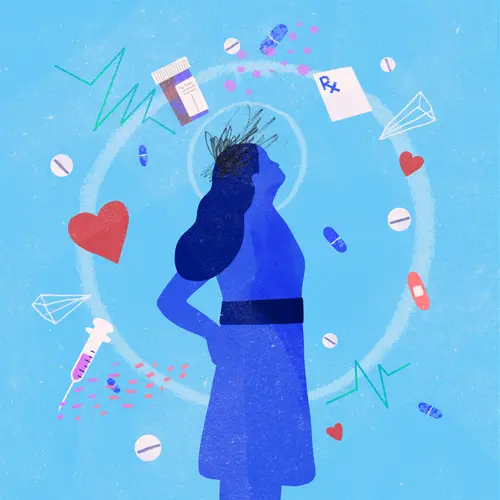What Is a Yeast Infection?
Yeast infections are caused by a type of fungus known as yeast, a single-cell organism found throughout the environment. Most of the time, your body can handle this fungus without any problems. But if your immune system is weak or you're taking antibiotics, you could get a yeast infection in any soft, damp part of your body.
Yeast infections in your mouth are called thrush. When you have a vagina, you could get vaginitis, or vaginal yeast infection.
Treating yeast infections generally requires antifungal medications. In most cases, treatment is simple, and it clears your infection right away. In some cases, you may need to complete multiple courses of treatment or use stronger, prescription medications to get rid of your symptoms.
How Do You Get Rid of a Yeast Infection?
The most effective treatment is doctor-prescribed antifungal medication. It's important to get medical attention if you have any symptoms. A yeast infection might overlap with a more serious health condition.
But you can try home remedies while waiting to see your doctor for a diagnosis and prescription. Here are some that may help.
Take probiotics. Many yeast infections happen when your immune system is busy or damaged. It's common to have yeast infections while on antibiotics because your body’s normal bacteria die off.
By taking probiotic supplements, which are made of live bacteria, you can help restore and maintain the natural bacteria population in and on your body. It keeps yeast infections from happening or worsening.
Eat yogurt. Yogurt is another healthy source of probiotics. Just make sure that you eat the yogurt. It doesn't offer any benefits when it's put on your skin, and the sugar present in it may even cause other infections.
Apply saltwater rinses. Yeast infections can sometimes be reduced and soothed by rinsing the area gently with saltwater. Mix a half-teaspoon of salt into a cup of warm water. For oral thrush, you can gently swish the mixture around in your mouth. For other areas of your body, you can soak the infected area for several minutes, then rinse thoroughly.
Apply coconut oil. Coconut oil seems to act as an antifungal agent both in the lab and in people.
You can gently apply a thin layer of coconut oil to the site of the yeast infection. This may help kill off some of the yeast and may soothe the irritated, dry skin, allowing it to heal.
Use tea tree oil. Some studies suggest that tea tree oil works well against yeast while not seriously affecting the bacteria that naturally live on the body. While more research needs to be done, tea tree oil may be a useful treatment.
You can find tea tree oil in suppositories, creams, and ointments, but it should not be applied undiluted. Applying tea tree oil frequently can lead to skin irritation and rashes, so use it in moderation.
Take antifungal medications. The most effective treatment for any fungal infection is to take antifungal medications. There are many medications available, including oral medications, topical creams, ointments, as well as suppositories for vaginal yeast infections. If you're sure you have a yeast infection, you can find some treatments over the counter. If you aren't sure, see your doctor.
If your yeast infection keeps coming back or isn't responding to other treatments, you can also request a prescription medication from your doctor. Make sure to follow the instructions for the drug, as antifungal medications are available in various strengths and can be taken in different ways.
Other natural treatments for yeast infections
Here are some lifestyle tips that may help prevent or lessen yeast infections:
- Keep your vaginal area cool and dry.
- Avoid food high in sugar.
- Don't douche or use vaginal deodorant.
- Avoid taking unnecessary antibiotics.
It's also important to get enough sleep, eat a balanced diet, and get regular exercise to boost your immune system when fighting a yeast infection.
What's the fastest way to get rid of a yeast infection?
For the fastest results, see your doctor for prescription meds.
When to See a Doctor
It's best to see your doctor when you have any signs of a yeast infection. They can make the right diagnosis and prescribe meds to help. They'll see if you have a more serious issue, such as a urinary tract infection or STI.
If you're pregnant, even over-the-counter vaginal creams need to be approved by your doctor.
If you have four or more yeast infections in a year, that's recurrent vulvovaginal candidiasis. You may need treatment for up to six months with an antifungal medication. Frequent yeast infections can be a sign of diabetes or another medical condition.
Takeaways
- Yeast infections are caused by a fungus that exists throughout the environment. Most of the time, your body can handle it without causing an infection.
- If you take antibiotics, have a weakened immune system, or have other issues, you may get a yeast infection in any soft, damp part of your body.
- Some home remedies may help ease your symptoms, but it's best to see a doctor to get the right diagnosis and meds if needed.
- Yeast infection symptoms can be signs of a more serious condition.
Yeast Infection Remedies FAQs
What drink kills yeast infections?
There's no evidence that any drink kills yeast infections.
Can I make a yeast infection go away on its own?
While some home remedies may help some yeast infection symptoms, it's best to see a doctor. You may need meds, or your yeast infection may be a sign of other health issues.
What increases the risk of yeast infections?
Taking antibiotics or having high estrogen levels, poorly controlled diabetes, or a weakened immune system can raise your risk for yeast infections.




